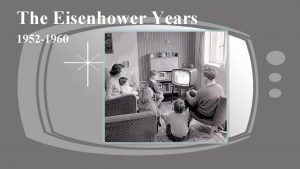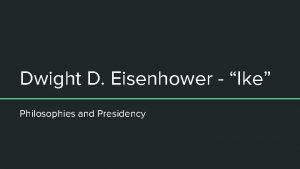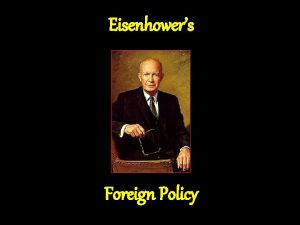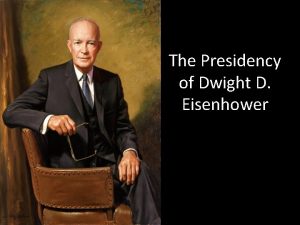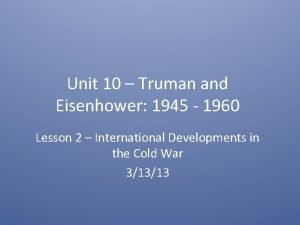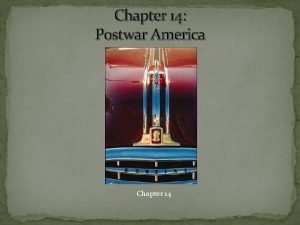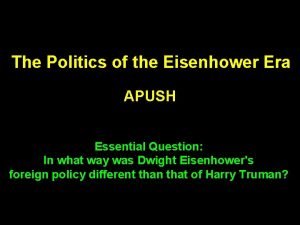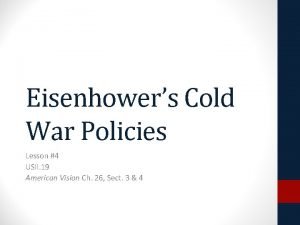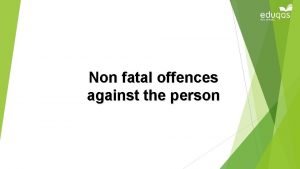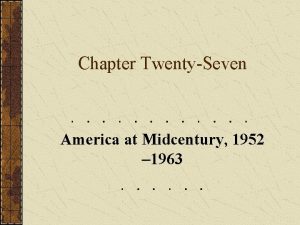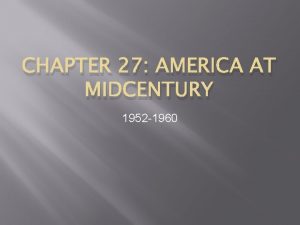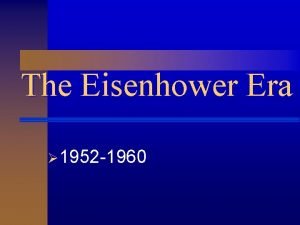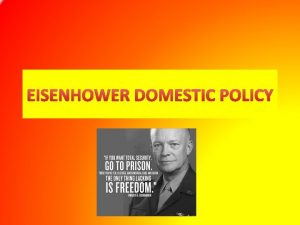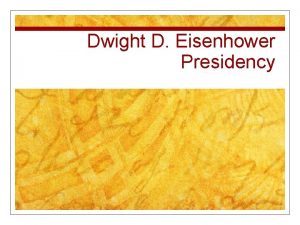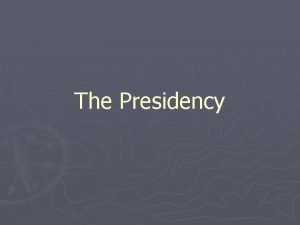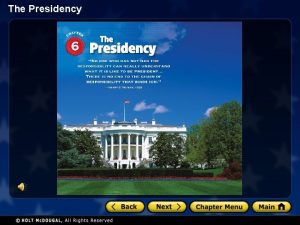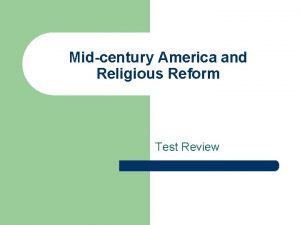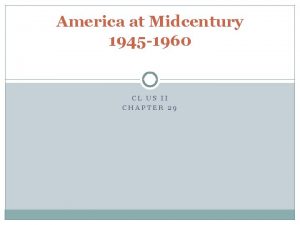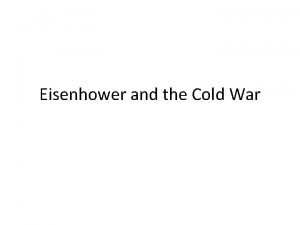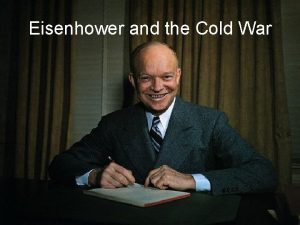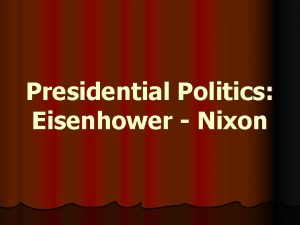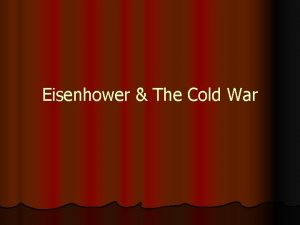America at Midcentury 1952 1963 The Eisenhower Presidency















- Slides: 15

America at Midcentury 1952 -1963

The Eisenhower Presidency “Ike” • First two-term Republican since Ulysses S. Grant • Secured passage for the Submerged Land Act of 1953, which transferred $40 billion worth of disputed offshore oil lands from the federal government to the Gulf States. • The Eisenhower Administrations lax approach to government regulation accelerated a trend toward destruction of the natural environment

Health and Medicine and the Expansion of Higher Education • More students attended college. • A college degree was a gateway to the middle class • Many dreaded epidemics like Jonas Salk pioneered the first vaccine against polio. Measles and Whooping cough disappeared from American life by 1960 • Less doctors continued making house calls; more people began going to hospital emergency rooms and patient clinics.

The New Music “Rock and Roll” • Re-invented American popular • • music He revitalized American popular culture as the teenage heart throb. Chuck Berry created music that defined what it meant to be young in postwar America African Americans added millions of white teenagers to their fan base. However, white cover versions of rhythm and blues originals outsold the black cover versions

Teenagers and Delinquency • Marlon Brando and James Dean epitomized the rebel attitude of the 1950’s • Rock and Roll was thought to be the reason why parents held less control over their kids. • Public perception of juvenile delinquency was over exaggerated.

Television: Tube of Plenty • The three main network were NBC, CBS and ABC; they grew directly • • • from radio stations. Advertisers spent $58 billion on TV shows in 1949; ten years later the figure was almost $1. 5 billion. The first great national TV hit was the, “Milton Berle Show” By the 1950’s TV shows epitomized the ideal suburban American family of the day. Shows like “Leave it to Beaver” and “Father Knows Best. ” Television created overnight fads and crazes across the nation The Cold War chill severely restricted the range of political discussions on Television. The 1952 election brought the first use of TV political advertising for presidential candidates.

The Beats • Led by novelists like Jack • • Kerouac and Allen Ginsberg. The beats shared a distrust of the American virtues of progress, power and material gain. The Beats celebrated spontaneity, friendship, jazz, open sexuality, drug use and outcasts. The term “beatnik” became associated with men and women dressed in black, wearing sunglasses and berets. They foreshadowed the cultural rebellion that was to come in the 1960’s.

Continuation of the Cold War • East Berliners rebelled against the Soviet Union in 1953 and the U. S did nothing to help • Hungarians revolted against the Soviet Union in 1956 and again the U. S did nothing except open their gates to refugees. • Joseph Stalin died in 1953 And Nikita Khrushchev succeeded him in 1956. • Relations warmed in 1959 until a U-2 spy plane was shot down over the Soviet union in 1960.

The Kennedy Presidency • John F. Kennedy (JFK), won the election of 1960 narrowly beating out Richard Nixon. • He was a young Roman Catholic president who was a war hero and Pulitzer Prize winning author for “Profiles of Courage” (1957). • In his inaugural speech he stated “Ask not what your country can do for you-ask what you can do for your country. ” • Under Kennedy, Congress approved a modest increase in the minimum wage ($1. 25 per hour), agreed to an improvement in Social Security, and Appropriated $5 billion for public housing.

Kennedy Continued • Kennedy increased the federal • • commitment to the Space Program Kennedy’s Programs were called the New Frontier Showdown between Kennedy and Khrushchev, the Berlin wall was built to Prevent East Berliners from escaping to West Berlin Peace Corps was developed in which volunteers worked for two years in undeveloped countries. Civil Rights movement began in the 1950’s with “sit-ins” and Freedom riders.

The Space race • In Oct. 1957 The Soviets launched the first man made object into space, a satellite known as Sputnik. • NASA (National Aeronautics and Space Administration) was established under Eisenhower. • NASA spent $33 billion on the Space Program before landing a man on the moon. • John F. Kennedy promises that the U. S. will have landed a man on the moon by the end of the century. Russian Scientist works on Sputnik.

Military Industrial Complex • Eisenhower warned against the Military Industrial Complex • He said, “The potential for the disastrous rise of misplaced power exists and will persist. We must never let the weight of this combination endanger our liberties or democratic processes. ” • Peace advocates argued against nuclear weapons saying that nuclear weapons did not strengthen national security but rather threatened the entire planet with extinction.

Bay of Pigs • Fidel Castro seized power in Cuba on • • • New Year’s Day 1959. The U. S. believed that a U. S. led invasion of Cuba would trigger an uprising and bring down Castro. On April 17, 1961 A ragtag army of Cuban exiles trained by the CIA landed on the Bay of Pigs in an attempted invasion. Without air support Castro’s efficient army quickly subdued them. The invasion strengthened Castro’s standing among Cuban’s At least eight attempts were launched by the CIA to assassinate Castro.

Cuban Missile Crisis • The closest the world has ever • • • come to a nuclear war. In October 1962, Castro asked the Soviets for help from the U. S. and Khrushchev responded by sending Castro sophisticated weaponry. The U. S. demanded that Cuba remove all the missiles and until then they would impose a naval blockade of all offensive military equipment shipped to Cuba. On Oct. 26 and 27 Khrushchev yielded. All the missiles were removed in return for a pledge from the U. S. to never invade Cuba.

Kennedy Assassinated • John F. Kennedy was • • assassinated by Lee Harvey Oswald on Nov. 22, 1963 Conspiracy theories still exist today as to who really killed JFK. Lee Harvey Oswald was gunned down on national television during his arraignment in Dallas. At the time of his death the Soviet Union and the U. S were more amicable than any time since the end of WWII. Lyndon B. Johnson became the 36 th president of the United States.
 The eisenhower years, 1952-1960
The eisenhower years, 1952-1960 Metoda eisenhower
Metoda eisenhower Eisenhower philosophy
Eisenhower philosophy Truman foreign policy vs eisenhower
Truman foreign policy vs eisenhower Matriz de eisenhower excel baixar
Matriz de eisenhower excel baixar Eisenhower
Eisenhower Lesson 1 truman and eisenhower
Lesson 1 truman and eisenhower Chapter 14 lesson 1 truman and eisenhower
Chapter 14 lesson 1 truman and eisenhower Dwight d eisenhower accomplishments
Dwight d eisenhower accomplishments Eisenhower domestic policy
Eisenhower domestic policy Matrice di eisenhower excel download
Matrice di eisenhower excel download Hermann göring
Hermann göring Containment apush def
Containment apush def Eisenhower middle school everett
Eisenhower middle school everett Lesson 4 eisenhower's cold war policies
Lesson 4 eisenhower's cold war policies Non fatal offences evaluation
Non fatal offences evaluation
